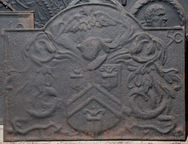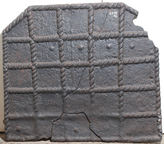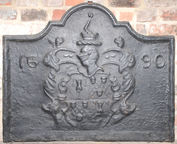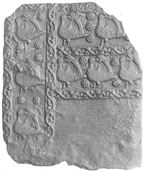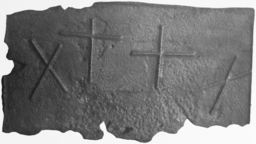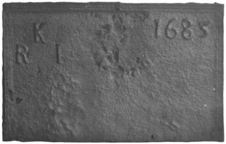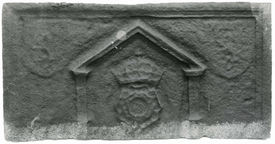-
458
Description: Fragment; bottom left corner missing; rectangular; ovolo-moulded edging; initials split by date across top of plate.
Notes: The numerals show the transition between archaic and modern type styles. Formerly part of the J. H. Every collection.
Inscription: S 1753 W
- Decoration tags:
- rectangular (shape)
- ovolo (edging)
- individual letters
- individual numbers
- text
Manufactured: in 1753 in the Weald area of England.
Current location: Anne of Cleves House, Southover High Street, Lewes, East Sussex, England.
Museum number: LH000.922 (part of the Sussex Archaeological Society museum group)
- Attached to series:
- Date & initials firebacks
-
459
Description: Arched rectangular shape; fillet edging; shield, helm, crest and mantling of the Worshipful Company of Blacksmiths; date in top corners; initials at bottom, below mantling.
Notes: One of the hooked ‘1’ series; unevenly impressed, the right more deeply than the left.
Copies of this fireback are known.
Inscription: 16 50 / I M
Arms: Worshipful Company of Blacksmiths
- Decoration tags:
- rectangular with round arch (shape)
- fillet (edging)
- whole carved pattern
- armorial
- text
Manufactured: in 1650 possibly at Brede Furnace in the Weald area of England.
Current location: Anne of Cleves House, Southover High Street, Lewes, East Sussex, England.
Museum number: 1933.34.046 (part of the Sussex Archaeological Society museum group)
Citation: Dawson, C., 1903, 'Sussex Iron Work and Pottery', Sussex Archaeological Collections, 46, pp. 1-54.
Citation: Gardner, J. S., 1898, 'Iron Casting in the Weald', Archaeologia, 56, 1, pp. 133-164.
- Attached to series:
- Livery company firebacks
- Hooked '1' series
- Brede group
- IM series
-
461
Description: Canted rectangle; twisted rope edging; irregularly spaced, 5 x 5 rope grid; damage to top right corner.
Notes: A 5 x 3 variant is also known.
- Decoration tags:
- rectangular with canted top corners (shape)
- rope (edging)
- simple stamps
- objects
Manufactured: in the mid- to late-16th century in the Weald area of England.
Current location: Anne of Cleves House, Southover High Street, Lewes, East Sussex, England.
Museum number: 1944.24.046 (part of the Sussex Archaeological Society museum group)
- Attached to series:
- Rope design firebacks
-
462
Description: Rectangular with an arched rectangular style arch linked by symmetrical concave curves; ovolo moulding (top and sides); shield, helmet, crest and mantling of the family of Baker, of Mayfield, quartered with Farnden, of Sedlescombe: Quarterly, 1st and 4th, Argent, a tower between three keys erect sable (Baker); 2nd and 3rd, Purpure, a chevron vairy Or and gules, between three leopards’ faces Or (Farnden); crest (Baker): on a tower sable an arm embowed in mail holding in the hand a flint-stone proper. Date split by mantling.
Notes: A carved armorial on a plain, edged base board. John Baker (1644-1723) married Ruth, daughter and co-heiress of Peter Farnden, in 1663; she died in 1691. During their marriage the Farnden arms, would have been borne as an escutcheon of pretence in the centre of the arms of Baker, and not quartered with those of her husband until after her death. The date, 1690, is therefore spurious and would have been added to a later copy of a mid-18th century armorial fireback (see no. 16).
Inscription: 16 90
Arms: Baker of Mayfield quartering Farnden of Sedlescombe
- Decoration tags:
- rectangular with canted top corners and round arch (shape)
- ovolo (edging)
- carved pattern panels
- individual numbers
- armorial
- text
Manufactured: in the 19th century in the Weald area of England.
Current location: Barbican House, High Street, Lewes, East Sussex, England.
(part of the Sussex Archaeological Society museum group)
- Attached to series:
- Ironmasters armorial series
- Personal armorial firebacks
-
854
Description: Sub-rectangular fragment; undulating vine tendril strip repeated twice vertically from left edge with a bird stamp (probably a swan, a Lancastrian badge) repeated three times between, interspersed with a grape cluster stamp repeated seven times; vine tendril stamp repeated twice horizontally at right angles to rightmost vertical strip, three bird stamps between strips and two above, interspersed with seven grape cluster stamps.
Notes: This fragment incorporates common elements from a large series of firebacks.
- Decoration tags:
- rectangular (shape)
- trailing vine (edging)
- carved stamps
- animals
- plants
Manufactured: in the mid- to late-16th century possibly at Pounsley Furnace, Framfield in the Weald area of England.
Current location: Anne of Cleves House, Southover High Street, Lewes, East Sussex, England.
Museum number: LH000.924 (part of the Sussex Archaeological Society museum group)
- Attached to series:
- Pounsley series
- Vine strip series
- Swan series
- Furniture stamp firebacks
-
1048
Description: Canted rectangular shape; twisted rope edging (top and sides); two saltires formed of twisted rope irregularly arranged.
Notes: The small size suggests a 17th rather than a 16th century date. Formerly part of the J. H. Every collection.
- Decoration tags:
- rectangular with canted top corners (shape)
- rope (edging)
- simple stamps
- apotropaic
- objects
Manufactured: in the late-16th to early-17th century in the Weald area of England.
Current location: Anne of Cleves House, Southover High Street, Lewes, East Sussex, England.
Museum number: LH000.919 (part of the Sussex Archaeological Society museum group)
- Attached to series:
- Rope design firebacks
-
1046
Description: Sub-rectangular shape; twisted rope edging (top and sides); two crosses between two saltires, all formed of straight lengths of twisted rope and irregularly arranged.
Notes: A poorly cast, and probably early, fireback. Formerly part of the J. H. Every collection.
- Decoration tags:
- rectangular (shape)
- rope (edging)
- simple stamps
- apotropaic
- objects
Manufactured: in the early- to mid-16th century in the Weald area of England.
Current location: Anne of Cleves House, Southover High Street, Lewes, East Sussex, England.
Museum number: LH000.917 (part of the Sussex Archaeological Society museum group)
- Attached to series:
- Rope design firebacks
-
1047
Description: Sub-rectangular shape, no edging; three impressions formed of a dagger (c.350mm) with fleur-de-lys terminals: two, at each end, with the handle uppermost, the other inverted lower right of centre.
Notes: The dagger (length approx. 39cm) can be described as a 'cross-hilt' or 'quillon' type, possibly of German origin (ex. inf. Tobias Capwell). The grouping of three daggers may also have apotropaic significance in relation to the Trinity. Formerly part of the J. H. Every collection.
- Decoration tags:
- rectangular (shape)
- none (edging)
- simple stamps
- apotropaic
- objects
Manufactured: in the 16th century in the Weald area of England.
Current location: Anne of Cleves House, Southover High Street, Lewes, East Sussex, England.
Museum number: LH000.920 (part of the Sussex Archaeological Society museum group)
- Attached to series:
- Knife & Dagger stamp firebacks
-
1050
Description: Rectangular; triple-moulded edging (top and sides); top left, initials RKI in triad; top right, date.
Notes: The initials probably relate to a husband and wife, the top initial being that of their surname. Formerly part of the J. H. Every collection.
Inscription: RKI [triad] 1683
- Decoration tags:
- rectangular (shape)
- complex, furniture-derived (edging)
- carved stamps
- individual letters
- individual numbers
- text
Manufactured: in 1683 in the Weald area of England.
Current location: Anne of Cleves House, Southover High Street, Lewes, East Sussex, England.
Museum number: LH000.921 (part of the Sussex Archaeological Society museum group)
- Attached to series:
- 1660s-90s Wealden series
- Date & initials firebacks
-
1053
Description: Rectangular; cyma curve and fillet edging; crowned Tudor rose within a pediment resting on Tuscan pilasters and pedestals; faint impression of a shield bearing a lion rampant repeated in each top corner.
Notes: The width of this fireback may indicate that another fireback in this series was used as its pattern and the shields added before casting.
- Decoration tags:
- rectangular (shape)
- cyma curve and fillet (edging)
- carved stamps
- whole carved pattern
- heraldic
- architectural
- armorial
- royal
Manufactured: in the mid- to late-16th century in the Weald area of England.
Current location: Anne of Cleves House, Southover High Street, Lewes, East Sussex, England.
Museum number: LH000.954 (part of the Sussex Archaeological Society museum group)
- Attached to series:
- Miscellaneous royal firebacks
- Pedimented rose and crown series

